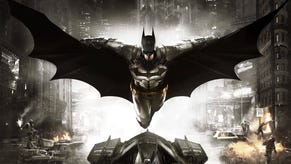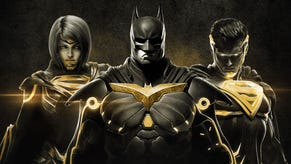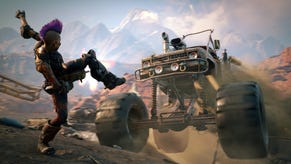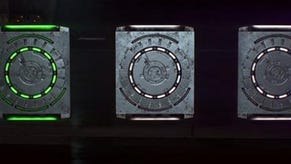Injustice 2 review
God rays.
Before you fight another player in Injustice 2, the game tells you your win odds. It's a slightly disconcerting thing to be presented with just before getting stuck into yet another online ranking match. You have a four per cent chance of winning, the game often tells me. Well damn. Bit of a lost cause, this, isn't it? And then I think, this is actually a lovely little touch from the developers at NetherRealm - one of many littered throughout this bulging fighting game package.
One of the things I like most about Injustice 2 is it thinks hard about how a fighting game should be played on a pad. The face buttons are used for the three main attacks: light, medium and heavy, and the character power. These powers are unique to each character. Batman summons a few bats he can set as a protective swarm or fire off as homing projectiles. Harley Quinn can set attack hyenas munching on her enemy. Swamp Thing raises Abigail's Garden from the ground. Any opponent caught in it cannot dash or jump. These powers are cool and, crucially, useful in a fight.
The smartest button, though, is the meter burn button. I love this button! Like Street Fighter's EX, Injustice 2's meter burn augments special moves. But unlike Street Fighter, Injustice 2 asks you to press the meter burn button immediately after the special move input command, so it's a bit easier to use. And in Injustice 2, augmented special moves typically extend the combo opportunity. It's a simplified system that essentially means "press the meter burn button to start a big combo" - and it works the same for all 29 characters.
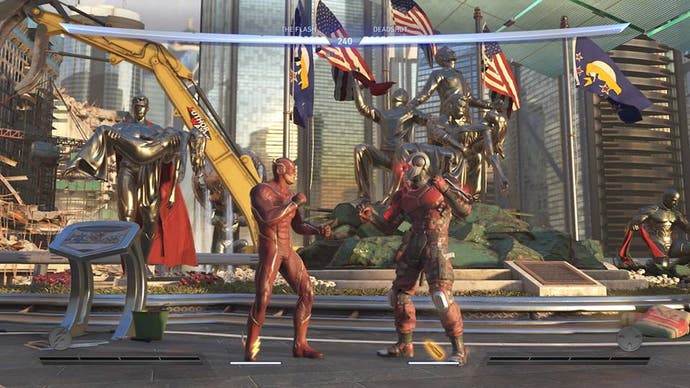
The meter burn button is also used for Injustice 2's raft of new mechanics, and it's here we get into the nitty gritty of the feel of the game. Two taps to the left and a press of the right trigger, or two taps to the right and a press of the right trigger does what's called a bounce cancel. This can be incorporated into most combo strings in the game, and sets up your opponent for a high damage juggle follow-up. However, a bounce cancel burns two bars of super meter. You can't spam it.
There are three quick escapes in the game, each using the meter burn button, If you're juggled, you can spend two bars of super meter to perform an air escape. This is key to success, as in Injustice 2 a huge amount of damage comes off of juggle combos. You can also burn one meter to block escape, which lets you interrupt a blocked combo to push away your opponent. This is incredibly useful if you're being pressured.
Most useful of all, though, is the roll escape. Forward, forward and the right trigger burns one bar of super meter for a near invincible escape. But I tend to use it more for closing the gap on characters who favour annoying keep-away tactics, such as Deadshot, Dr. Fate and Harley Quinn. Injustice 2 already feels like a zoner's fighting game, with a number of characters able to spam projectiles from an entire screen away (it's early days but Deadshot can do one!).
Given there's a meter burn button, it shouldn't come as much of a surprise to hear that Injustice 2 is heavy on meter management. I'm always mindful of how much meter I've got in this game - more so than in other fighting games I play - because so many crucial moves and techniques rely upon it.

Take the Clash mechanic, for example. When you're down to your second life bar, you can interrupt a combo to trigger a Clash. Here, both characters come together - with a dash of trash talking - to wager meter on a clash. If you spend more bars of meter than your opponent, you win the Clash and either do damage or recover health. That sounds simple enough, but the strategy comes from knowing when to take the hit on the Clash and save your meter instead. You might even try to bait out meter use by triggering a Clash you have no intention of winning. It's a surprisingly tactical thing.
All these meter burn moves combine to give Injustice 2 the feel of a fighting game that wants to help you out. Getting pummeled by constant pressure? Block escape. Getting jabbed by endless projecticles? Roll escape. The thing you have to remember is, all these options require meter, that most precious of resources. I hardly ever use my high damage super attack, which requires a full meter bar, so useful is each bar of meter for other things in this game.
Of course, some players won't want to touch the competitive side of Injustice 2, which is fair enough given how brutal online play against other humans can be. Thankfully, the game has a huge amount to offer those who'd prefer to stick to smashing up the computer, with NetherRealm once again proving it's the best in the business at that old chestnut: content.
The story mode is particularly impressive. This enjoyable, five or so hour adventure picks up the action with Superman behind bars and his brutal Regime in tatters. But the invasion of Brainiac forces Batman to consider the unthinkable: free Superman so he can help save the Earth. As you'd expect, pretty much all the superheroes have something to say about that, and everyone ends up smashing each other to bits. The Batman vs Superman conflict is well-worn at this point, and just like the film, Injustice 2's dialogue could do with a few more jokes, but the plot breezes on regardless, and I was never bored throughout.
On a technical level, there's plenty to admire about Injustice 2's story mode. You get to play as most of the cast, the motion capture is solid and the action choreography occasionally superb. The voice acting is consistently great, too. Kevin Conroy reprises his long-standing role as Batman and does a fine job. Alan Tudyk has a lot of fun with the wise-cracking Green Arrow, and Jeffrey Combs, who Star Trek fans will know as the annoying Weyoun from Deep Space Nine, is wonderful as the nonchalant supervillain Brainiac.
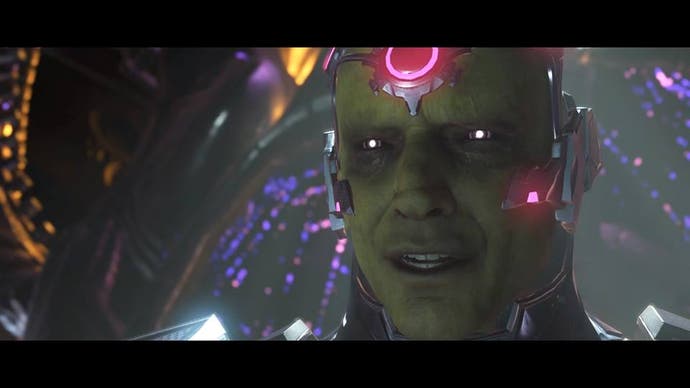
Graphically, Injustice 2 is a significant step up from 2013's Injustice: Gods Among Us, which was hamstrung by the previous generation of consoles. Some of the stages, such as Kahndaq, are stunning. And the character detail is second to none. NetherRealm has created impressively realistic visuals that nail the dour, love it or hate it art style of the current DC cinematic universe, but that's not to say the game is devoid of flair. NetherRealm, often criticised for its character animation work, has found alternative areas to excel in. I love the way the characters take cheap shots at each other on the select screen. I love Harley Quinn's victory saunter as she chucks dynamite over her shoulder. I love Flash's super fast punch flurry that lands after he's performed the punches. I love Swamp Thing's many tendrils that protrude from his slodgey being. And I love Supergirl's Walking Heat Vision, a special move that sees the true star of Injustice 2 stride menacingly forward, red laser beams blasting out of her eyes.
But it's the faces that stand out the most. NetherRealm has really outdone itself with Injustice 2's facial animations. Pretty much all of the characters look the part, with realistic expressions, mannerisms and head bobs. The eyes are brilliant, too. Supergirl, Brainiac, Harley Quinn and Black Canary are the best of the bunch. I can't help but see Ross from Friends in Batman, though, and it almost ruined everything for me.
When you're done with the story, those who favour single-player modes have the Multiverse to keep them going. This is a regularly updated series of challenges of varying difficulty that add outlandish modifiers into the mix. It might be an occasionally electrified floor that does damage to both characters, that sort of thing. Multiverse is a nice idea, and I appreciate the attempt to create a kind of DC-themed portal you fancy returning to day after day, but for me the motivation to play is more fuelled by the prospect of better loot than it is by potential fun.
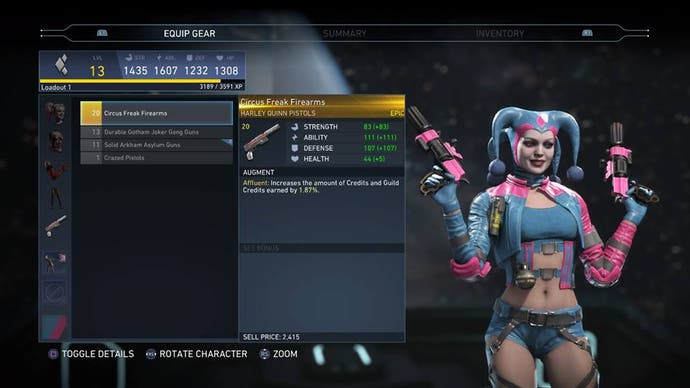
Ah, loot. Injustice 2's much discussed gear system lets you equip different pieces of armour and clothing to make your character not only look different, but more powerful. Equipment can boost one of four base stats: strength, ability, defense and health. Some of the more powerful items carry augments, such as increasing the amount of damage you do under certain circumstances. There are gear set bonuses, and you can even equip abilities that trigger some effect, such as making a special move work differently.
There's a lot to like about Injustice 2's gear system. I really enjoy customising the characters I care about with different outfits, and some of the epic gear sets look brilliant. But stats in a fighting game? We've been here before, haven't we, namely with the gems system in Street Fighter x Tekken - and look how that game turned out.
Injustice 2 does have what's called competitive mode to fall back on. This fiddly system sees both players rush to agree upon a set of rules just after the characters have been picked. One of the parameters is the ability to toggle gear stats on or off. The thing is, both players must be unanimous in their decisions before they take effect. If the players want different things, Injustice 2 reverts to its default position: gear stats enabled. I find in most matches players stick with gear stats enabled. Clearly, the community is up for it.
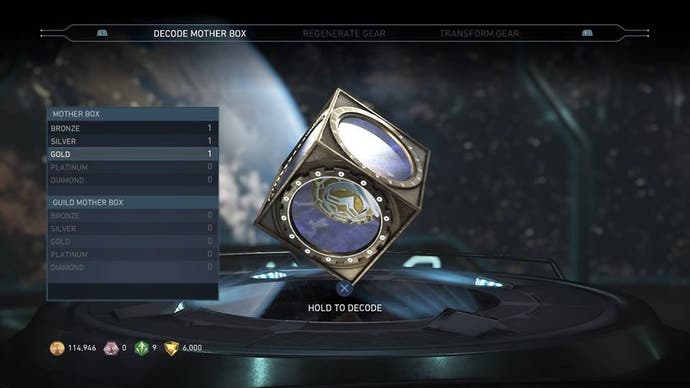
Because Injustice 2 is a game that has come out in 2017, it has blind loot boxes and the loot you get is governed by some random number generator. The game is quite generous in the dishing out of the Mother Boxes, as they're called. After I finished the story I had a load to "decode". And you can buy more with the in-game credits, if you're after more random loot. But the whole thing feels a little frustrating. Most of the time I don't get an item for the handful of characters I play as. Green Arrow legs? Thanks for nothing. Black Canary arms? Sell for credits!
Loot boxes spark the dreaded microtransaction fear, but you can't buy Mother Boxes with real world money, which at least demonstrates some restraint on the part of the analytics people at Warner Bros. Rather, you can buy Source Crystals with your hard-earned cash. This virtual currency can only be used to buy cosmetic items, Premiere character Skins and shaders. So you never feel as if you've been outgeared by someone with considerably more money than you. But you do occasionally feel that you might have been outgeared by someone with considerably more time - and luck - than you.
Despite annoyances with the gear system and the loot boxes, Injustice 2 is a huge amount of fun. There's tonnes of stuff to do, it looks the part and the new fighting mechanics serve a purpose while deftly avoiding adding complexity. Injustice 2 is also a game I thoroughly appreciate for the lovely little touches. I appreciate that NetherRealm has put frame data into the move list. I appreciate there are character-specific tutorials. I appreciate there's a tournament mode that lets you battle offline with no progression or rewards. I appreciate how over the top the supers and stage transitions are. And I appreciate the character's eyes seem to look in the right direction. In short, Injustice 2 is the complete fighting game package, and it's one I hope other developers in the genre take notice of.



